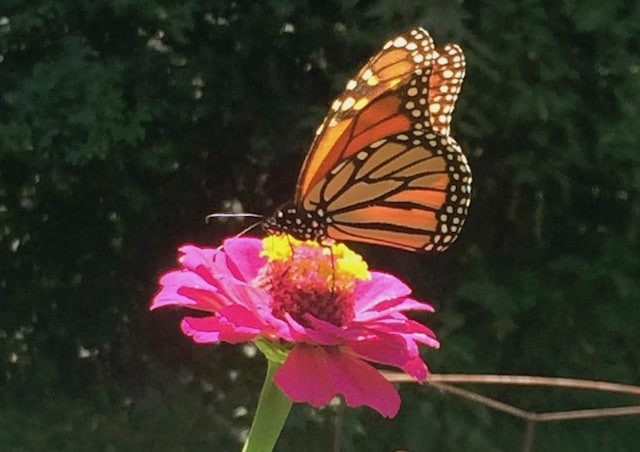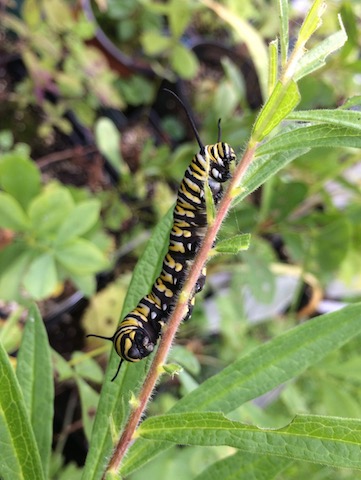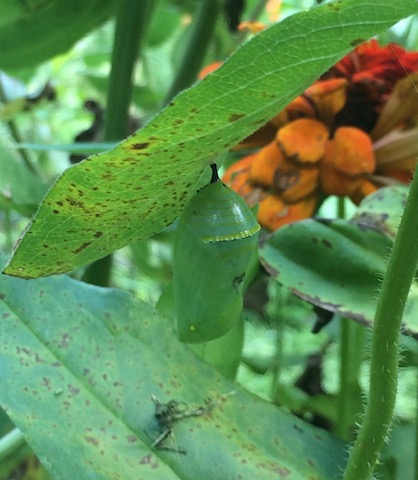
The Magnificent Monarch Migration!
Published by Anne Altor on Sep 2nd 2017
Migrating monarchs!
Through wind and rain, around predators and human obstacles, monarch butterflies fly up to 3000 miles in late summer to their wintering grounds in Mexico and California!
Most butterfly species that live in temperate climates have adapted to freezing winters. Many overwinter as caterpillars or pupa. Some overwinter in the egg stage or as dormant adults in shelters like holes in trees. Monarchs can't survive the cold, and they make an incredible 1000 to 3000-mile migration to overwinter in a particular forest in Mexico or in coastal California.
The monarch's journey from south to north and back
takes place over 3 to 4 generations. The summer generations live 2 to 5 weeks. Their role is to reproduce and move the population north. The last generation of the year (gen 3 or 4) is born in late summer and makes the incredible flight to the wintering grounds, and then starts the return journey the next spring. These butterflies live up to 9 months.

Map of North American monarch range and migration, by MonarchWatch.org
Monarchs have a fascinating life cycle, & it depends on milkweed:

Monarch caterpillar on butterfly milkweed (Asclepias tuberosa). Photo by Anne Altor
The butterflies leave their winter homes in March, mate and lay their tiny eggs under milkweed leaves as they move up to northern Mexico and the southern US. Caterpillars emerge from eggs after 3 to 8 days and begin eating milkweed. The caterpillars go through 4 molts, shedding their skin as they grow. After 9 to 17 days, they form a chrysalis and transform into butterflies that continue the journey north, laying eggs on milkweed along the way. This continues for two more generations.
If generation-3 butterflies emerge early enough, they may raise a fourth generation, but butterflies that emerge in late summer won't reproduce until the following spring. These late-summer butterflies are the migratory adults that make the incredible flight south between September and early November.

Monarch chrysalis on zinnia leaf. Photo by Anne Altor
To migrate as a butterfly
would be challenging in its own right. Now monarchs are threatened because of logging in Mexico in their winter forest and because of habitat loss throughout the US. This includes loss of their milkweed host plants and nectar plants that are replaced by suburban lawns or destroyed by mowing and herbicides. But our collective action can make a positive difference! Here are some things you can you do to help:
1. Plant milkweed!
If a female monarch can't find milkweed plants, she can't lay her eggs. Monarch caterpillars eat nothing but milkweed, and this plant infuses them with compounds that are toxic to predators and help them survive. You get the additional benefits of beautifying your lawn with these lovely plants and attracting other pollinators.
2. Avoid using herbicides and pesticides on your lawn!
In addition to harming monarchs, they destroy other insects that provide needed food for birds and that pollinate the foods we humans eat every day.
3. Plant a pollinator garden!
If you don't have a yard but you have a porch or patio, potted plants work for pollinators too! Pollinator gardens are not only beautiful, they provide critical food sources for adult monarchs and other butterflies and insects. Suburban areas have destroyed massive amounts of habitat, but we can help revitalize these areas and make them more friendly to species that have been pushed out. Planting for pollinators and minimizing use of chemicals are important ways to restore a little bit of wild to human-dominated landscapes.
The amazing monarchs you might be lucky to see this fall are on a journey thousands of miles south that this species must make every year to survive. Let's do what we can to help them!
Great sources for more information on monarchs:
The Xerces Society for Invertebrate Conservation
The Butterflies of North America: A Natural History and Field Guide
